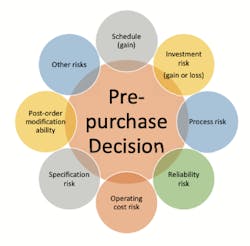When it comes to project management, change creates both challenges and opportunities. Market opportunities come and go, political changes drive regulatory changes and technology creates new opportunities. All projects require some commitment of capital and future operating costs. Reducing the time between having a concept and getting a project into the field and making money reduces the uncertainty of future changes making a project unprofitable.
Recent increases in interest rates have also increased capital sensitivity. The shorter a period between capital commitment and earnings return reduces financing charges.
Both these factors continue to maintain pressure on the long-term drive to reduce project execution times. Regretfully, equipment delivery times have not improved over the last several years. If anything, complex, major equipment has longer lead times than ever. One area this is especially true for is major machinery such as compressors.
Of course, one response is to pre-order long-lead equipment early. Early ordering has the benefit of reducing project execution time, but it does have some potential costs. How the costs balance is critical in deciding if to early order. The benefit-balance for early ordering changes with the situation. Figure 1 illustrates the balance behind the decision for a recent case of an early order of three screw compressors. The specific points included one with a clear benefit, one with an unclear cost-benefit balance and six areas that had possible costs. All had to have some evaluation to understand if early-ordering was attractive.
The clear benefit area of early ordering was many months of schedule savings. In fact, after the early order the compressors were no longer on the critical path for project execution.
The unclear area was in investment risk. Ordering now commits capital earlier. This may bring finance charges and make capital unavailable for other investments. Additionally, the project may be canceled after the order. This risk can be reduced by careful negotiation of explicit cancelation charges with the supplier. Prices can also change. Ordering now may mean that future price drops if the equipment market softens cannot be captured. However, ordering now can lock in supply and avoid future price increases. Overall, investment risk for the compressor order was judged to be a minor factor and could be in either direction. It had no significant affect on the early-order decision in this case.
The other five explicit but inter-related areas analyzed were post-order modification ability, specification risk, process risk, reliability risk and operating cost risk. Finally, other miscellaneous factors were lumped together under other risk.
Post-order modification risk included potential costs of having to modify the order if some critical change had to be made. This risk of modifications can be reduced by increasing the flexibility of the purchased compressor. But increased flexibility nearly always incurs both capital and operating costs. The overall balance for this case was that some flexibility would be added up to about 5% increase in compressor capital cost plus 1-2% increase in operating cost. This was judged as being clearly worth the expense given the amount of schedule gain.
Process risk was the ability of the compressors to meet required process conditions even if the final feed composition was changed. Since screw compressors are positive displacement machines, molecular weight changes to the feed had only a minor impact. The largest risk was that a higher molecular weight would lead to increased power demand and exceed the motor capacity. As a result, extra motor power was added. The cost of this change was included in the flexibility cost analysis mentioned previously.
Specification risk applied to the decision to not require the compressor API (American Petroleum Institute) standards. An off-the shelf, vendor-standard compressor was purchased instead. This decision reduced cost and made delivery faster. The potential cost was reduced reliability. However, with three parallel machines in service, the plant would still be able to run. Increased maintenance costs and some loss of future capacity might result, but the increased production from a sooner startup more than compensated for this decision.
Other risks combined multiple factors, but none were significant enough to influence the decision either for or against pre-purchasing.
Early purchasing is usually done when time is critical. The final decision to pre-purchase was overwhelmingly justified by many months of reduced delivery time and a much sooner unit startup. As discussed, short-cut evaluations that mix qualitative and quantitative criteria are often used. Experienced engineers with a breadth of experience are required to balance the factors and make the quick decision needed.




